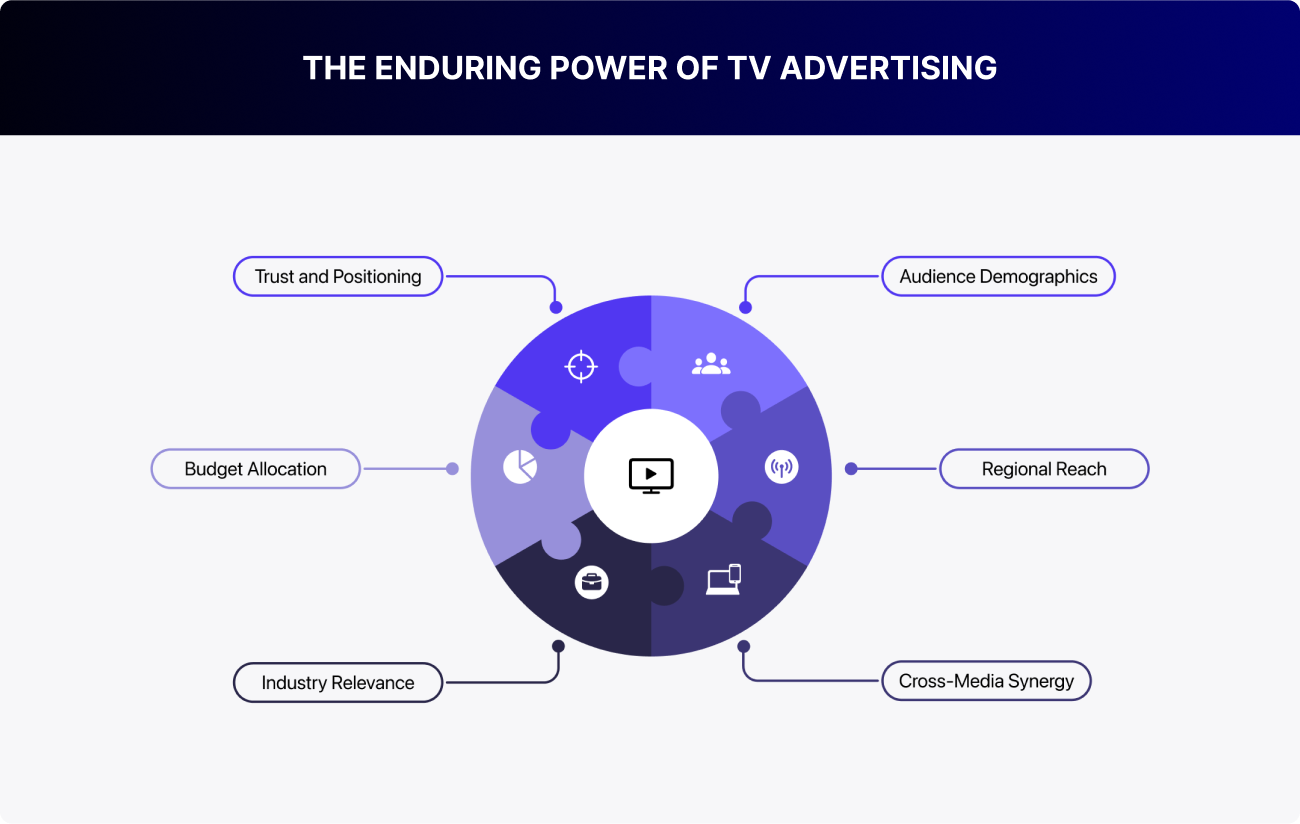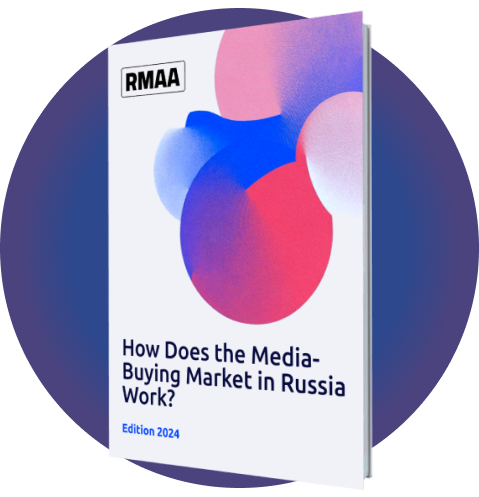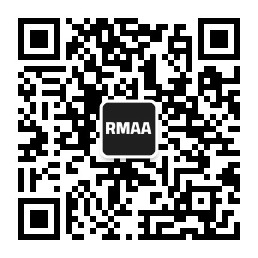Blog about successful marketing strategies in russia
TV Advertising in Kyrgyzstan: Why It’s Worth Watching in 2025


MEDIA BUYING
Share this Post
Digital is making the loudest noise — social media, influencers, paid social. But while some brands chase after reels, others steadily maintain their reach through TV. And, it quite successfully, we should say.
Last year, TV remained the largest platform in terms of advertising budgets in Kyrgyzstan. Forecasts indicate that by 2025, spending on TV and video ads (including online video) will reach approximately $16.5 billion. This channel is especially popular among pharmaceutical companies, FMCG brands, and government clients.
Bishkek is digital and young, but once you step outside the capital, TV becomes the main window to the world again. That’s where brand trust is built, and where advertising doesn’t just aim to be seen but to be believed.
Who Watches TV in Kyrgyzstan Today
TV remains the primary source of information for the older generation and rural residents. Young people are turning more to YouTube and TikTok. For example, in Bishkek, only about 41% of city dwellers can be considered active TV viewers, despite the wide range of channels available.
TV consumption is mainly in Kyrgyz and Russian. Even in southern regions with a large Uzbek-speaking population, such as the Osh region, content is mostly consumed in the two state languages. National channels, including KTRK and OTRK, broadcast in Kyrgyz with partial Russian dubbing. Private broadcasters such as NTS and Piramida tend to target the Russian-speaking audience. Uzbek language is barely represented on air as it lacks formal support.
Brands should take audience language into account: mass-market products are better promoted in both Kyrgyz and Russian from the start. In Bishkek, Russian-language advertising works fine, but in Osh, it requires localization, at least with a separate Kyrgyz-language version.
In the capital, TV is increasingly background noise with the audience spread across Netflix, TikTok, and YouTube. Meanwhile, in the regions, TV remains a shared family screen. In Osh, for example, Osh TV is watched regularly, and local channels have more influence there than in Bishkek.
The programming schedule is predictable: shows in the morning, series in the afternoon, news and movies in the evening. National channels attract the biggest prime-time audiences. That’s where most advertising budgets go.
After digitalization, the TV signal covers nearly the entire country. Besides terrestrial TV, cable and satellite operators are active. Today, about 95% of viewers regularly watch programs on around twenty key channels.
| Parameter | Bishkek | Regions |
|---|---|---|
| TV audience age | 45+ | 35+ and older |
| Main broadcast language | Russian | Kyrgyz / Russian |
| Media behavior | YouTube, TikTok, Telegram | TV, WhatsApp, regional channels |
| Digital penetration level | High (up to 90%) | Moderate (60–75%) |
| Broadcast type | Cable, IPTV | Terrestrial, Satellite |
| TV role | Background channel | Primary source of information |
| Popular channels | OTRK, Pyramid, NTS | EITR, Osh TV, regional broadcasters |
Who Sets the Tone: Top Channels on Kyrgyz TV
There are around 60 TV channels in the country, but roughly 25 provide significant advertising reach. All ad sales are effectively managed by a single sales house — TV Media Kyrgyzstan, which can either simplify or complicate things for brands, depending on their budget and goals.
The most influential channels in terms of reach and trust are:
| Channel | Approximate National Reach | Content Type | Broadcast Language |
|---|---|---|---|
| KTRK (OTRK) | ≈98% (maximum, nationwide coverage) | News, socio-political | Kyrgyz |
| Russia – RTR | ~65–70% (especially strong in Bishkek) | News, TV series | Russian |
| KTRK “Balastan” | ~60% (children + parents) | Children’s and youth content | Kyrgyz |
| EITR | ~75–80% (nationwide, southern focus) | News, culture, regional programs | Kyrgyz |
| KTRK “Ala-Too 24” | ~55–60% (24/7 news broadcasting) | News and current affairs | Kyrgyz |
| Channel One Russia (ORT) | ~50–55% (strong in urban areas) | Entertainment, series | Russian |
| NTS | ~50–55% (leading private broadcaster) | Info-entertainment | Kyrgyz |
| KTRK “Music” | ~45–50% (nationwide music content) | National and pop music | Kyrgyz |
| 7 Kanal | ~40–45% (universal, multiplex access) | Family and entertainment | Kyrgyz / Russian |
| TNT Asia | ~35–40% (urban youth-oriented) | Comedy, shows, series | Russian |
Most of these channels are available via digital TV and satellite, not only within the country but also beyond its borders. This is important for brands aiming to catch the attention of the diaspora, especially in Russia and Kazakhstan.
Why is Russia – RTR ranked above ElTR despite ElTR having a larger reach?
At first glance, this might seem odd. ElTR is indeed watched more, particularly in the southern parts of the country. However, ratings are based not on the number of viewers but on influence over the media market.
Russia – RTR holds a strong position in advertisers’ media plans, especially in Bishkek and other major cities. The channel offers recognizable content: news, series, and analytics. Its audience is Russian-speaking, urban, accustomed to online shopping, and values stability. Even with slightly lower reach, this channel carries more weight.
ElTR is more popular among rural and Kyrgyz-speaking audiences. It has mass viewership, but this audience is less engaged with digital media and less responsive to advertising. That’s why advertisers prefer Russian channels, despite their smaller reach, as they deliver a more active audience.
What’s on TV: Today’s Content
TV channels in Kyrgyzstan have long since found their niches: each has its audience and format. Some focus on news, others on evening shows or cartoons. Before launching a TV campaign, it’s important to understand who specializes in what.
KTRK (OTRK) remains the country’s main news and socio-political channel. It’s turned on to stay updated on the official agenda, especially in the regions. The 24/7 news flow is supported by Ala-Too 24, a channel from the same group, focused on fast and regular news delivery.
Among Russian broadcasters, Russia–RTR maintains a strong position, mixing news with series and talk shows. Channel One (ORT), another player in the Russian media landscape, emphasizes entertainment and feature films. It’s mostly watched in cities and primarily in Russian.
If a brand targets entertainment and family formats, channels like NTS, 7 Channel, and TNT-Asia are worth considering. The first combines news with entertainment blocks, the second is versatile and tailored for a broad audience, and the third caters mainly to a younger crowd with urban humor.
Regional topics and cultural stories are especially well covered on ElTR. This channel is strong in the southern regions and focuses on Kyrgyz-language content, including folklore, traditions, and local issues.
Children’s content is almost entirely concentrated on KTRK “Balastan”. Practically, this is the only channel aimed at kids and parents. It covers the entire country and consistently ranks among the top three in popularity.
The music segment is covered by KTRK “Muzyka”, which features national hits, pop, and festive broadcasts. The channel usually plays in the background, but suits light brands and emotional positioning well.
As for niche formats, they are weakly represented in Kyrgyzstan. There are virtually no dedicated channels for teens, youth, or lifestyle audiences. This traffic has long since been taken over by YouTube and TikTok.
Legislation and Regulation: What You Need to Know Before Launching a TV Campaign
The advertising market in Kyrgyzstan remains relatively open, especially compared to Uzbekistan or Tajikistan, with fewer formal restrictions, making it easier for brands to adapt. The Ministry of Culture, Information, Sports, and Youth oversees the media space. It sets general policies and monitors what is allowed and what isn’t. The national broadcaster KTRK often serves as a platform for government initiatives, particularly on TV. When ads involve financial services or dietary supplements, the antitrust authority and the Financial Control step in.
There are restrictions. Advertising for strong alcohol is prohibited, and tobacco ads are completely banned. Only over-the-counter medicines can be advertised; anything related to prescription drugs is strictly forbidden. There is ongoing discussion about limiting the promotion of sweets and snacks during the day near schools. Though no law exists yet, the debate continues. Meanwhile, pharma remains one of the largest advertisers. Their commercials often occupy prime time and appear in news segments.
There are no language requirements for ads — Kyrgyz dubbing is not mandatory. However, in practice, commercials are usually bilingual. Russian is more commonly used in Bishkek, while Kyrgyz dominates in Osh and Naryn. Brands adjust their campaigns to regional specifics.
Subtitles are not mandatory but are often added, especially for medicines or social ads. Duration is standard, with lengths of 5, 30, or 60 seconds. The label ‘Advertisement’ must appear at the beginning and end of the commercial. Sometimes, product placements appear in shows; for example, the phrase ‘supported by’ replaces a clear ad label. This borders on covert advertising, but the format is used.
Overall, the market is still under state control, but there are emerging attempts at self-regulation, particularly in digital and BTL areas. A unified audience measurement system is in development, and if implemented, it will increase transparency.
Content blocking does happen. The most common reasons include pirated video content on satellite channels, fake supplements, and financial pyramids. This is closely monitored during prime time. Authorities have already announced plans to tighten control in this area.
Why Brands Still Invest in TV
Demand for TV advertising in Kyrgyzstan isn’t holding up because digital hasn’t arrived. It’s because TV still delivers, especially where trust, reach, and consistent brand perception matter most.
For audiences over 40, TV remains the main source of information. It doesn’t irritate, requires no swiping, and isn’t pushy. People turn it on out of habit, and it’s simply there. This is especially true in the regions. Telegram doesn’t always reach everyone, TikTok isn’t accessible to all, but TV is in every home. So if a brand wants to be ‘in every household,’ not just in every feed, TV is indispensable.
The combination of TV plus outdoor advertising or paid social works well. Someone sees a commercial on TV, then spots a banner on the street, and maybe a few days later encounters the same brand on Instagram. This builds recognition. Even if the purchase decision isn’t immediate, the brand is already familiar. This is particularly important for pharma, banks, and everyday products.

In these sectors, TV remains essential. Pharma is the biggest TV advertiser, and this hasn’t changed for years. Financial companies, government agencies, and social campaigns still rely on TV. The reason is simple: TV provides not just reach but also weight. A brand that appears on screen is taken seriously.
According to analysts’ estimates, in 2024, TV accounted for about 25–27% of the country’s total advertising budgets. It’s the second-largest channel after digital. And although growth is slower than on social media, TV’s reach remains solid, especially for national channels like KTRK, ElTR, and Balastan.
In a landscape where digital grabs attention but not trust, television in Kyrgyzstan is less a mass medium and more a tool for precise positioning. It doesn’t work for everyone, but where it’s needed, it works reliably.
Ranking of the Largest TV Advertisers in Kyrgyzstan
Last year, companies from pharmaceuticals and healthcare, FMCG (everyday consumer goods including food and beverages), and telecommunications spent the most on TV advertising in Kyrgyzstan. These three sectors accounted for the lion’s share of TV ad budgets.
For comparison, back in 2017, the top 10 product categories made up about 82% of TV channel revenues, and by 2022, this concentration had increased; the top 10 categories accounted for around 90% of the market. In 2024, pharma leads, while telecom companies, once among the top three categories, have cut back on TV activity since 2020 and no longer rank in the top three. The main advertiser sectors are outlined below:
| Industry | TV Ad Spend | Frequency | Audience Reach* |
|---|---|---|---|
| Pharmaceuticals & Healthcare | ≈ $3.0–3.5M (approx. 30% share) | Very high (thousands of spots/year) | Up to 85–90% of TV viewers |
| FMCG (food, beverages, etc.) | ≈ $2.0–2.5M (20–25% share) | Very high (thousands of spots) | ~80% of TV viewers |
| Telecommunications | ≈ $1.5–2.0M (around 15%) | High (thousands of airings) | ~75–80% of TV viewers |
| Banking sector | ≈ $0.5M (estimated <5%) | Moderate (hundreds of ads) | ~50–60% of TV viewers |
| Automotive sector | ≈ $0.3–0.4M (a few % share) | Low (dozens to hundreds of spots) | ~40–50% of TV viewers |
| Other sectors (retail, real estate, services, etc.) | ≈ $1.0–1.5M total (10–15%) | Varies (from moderate to high) | ~50–70% of TV viewers |
*Estimated audience reach refers to the share of the country’s viewers who have seen advertising from a given category at least once during the year. Weekly TV audience** in Kyrgyzstan nearly covers the entire population. With the switch to digital TV, technical coverage has reached around 95%, meaning major advertisers can deliver their ads to most (~ 80 %+) of the country’s residents annually.
Pharmaceuticals lead in TV ad spending. By 2024, the budget grew by 59.5%, reaching $4.5 million. Medicines, vitamins, and medical services ads dominate the airtime. Both international brands (such as Berlin-Chemie) and major local clinics (like the Hong Kong Center) are active. The volume of placements is in the thousands per year, with a reach of up to ~85%.
FMCG ranks second. This includes food products, drinks, household chemicals, and hygiene items. The segment contributes about 25% of TV ad revenue. In 2024, brands like Coca-Cola, RG Brands, and Wimm-Bill-Dann (PepsiCo) were actively advertising. Frequency is high, with reach around 80%.
Telecom holds third place. Although its share has declined since 2017 (when cellular services accounted for $3.15 million, +15.6%), in 2024, Beeline, O!, and MegaCom remained active. Their annual spending is about $1 million each, with a reach of between 75–80%.
Banks and automotive spend less. In 2024, banks invested around $0.5 million in TV ads (under 5% of the market), with hundreds of commercials aired annually and reaching about 50%. Auto brands appeared less frequently, with a total budget of several hundred thousand dollars and reach around 40–50%.
Other categories, including retail, electronics, real estate, and entertainment, accounted for 10–15% of the total budget. In 2024, mass-market segments (retail and entertainment) covered up to 60–70% of the audience, while niche sectors had more limited exposure.
Top 10 Advertisers (Companies and Brands) on Kyrgyz TV
The ranking of specific TV advertisers in Kyrgyzstan is dominated by international companies and the largest local firms. According to experts, traditionally, 10–15 of the top 20 TV advertisers are multinational or foreign companies. However, several local brands also rank among the biggest spenders. Below is an approximate top 10 list of companies/brands by TV ad spend in 2024, including their industry and estimated metrics:
| Rank | Advertiser (Brand) | Industry | Estimated TV Budget | Number of Spots* | Audience Reach |
|---|---|---|---|---|---|
| 1 | O! (NUR Telecom) | Telecom (Mobile) | ~$1.0M (≈1st by spending) | ~8–10K per year | ~85% (nationwide) |
| 2 | Beeline (Sky Mobile) | Telecom (Mobile) | ~$0.9–1.0M | ~7–8K | ~80–85% |
| 3 | Coca-Cola | FMCG (Beverages) | ~$0.7M | ~6K | ~75–80% |
| 4 | MegaCom (Alfa Telecom) | Telecom (Mobile) | ~$0.5–0.6M | ~5K | ~70–75% |
| 5 | Hong Kong Medical Center | Medical Services | ~$0.5–0.6M | ~5K | ~70% |
| 6 | Berlin-Chemie/Menarini | Pharmaceuticals | ~$0.4–0.5M | ~4K | ~65–70% |
| 7 | Aknet | Internet Provider | ~$0.4M | ~4K | ~60–65% |
| 8 | RG Brands | FMCG (Beverages) | ~$0.4M | ~3–4K | ~60% |
| 9 | Wimm-Bill-Dann (PepsiCo) | FMCG (Food Products) | ~$0.3–0.4M | ~3K | ~55–60% |
| 10 | GMP (Pharma company) | Pharmaceuticals | ~$0.3M | ~2–3K | ~50–55% |
*The number of commercials is estimated based on spending volumes and average placement costs; reach refers to the share of viewers who have seen the company’s ads at least once during the year.
Together, the top 10 advertisers generate a significant portion of TV advertising. As of 2024, their share remains comparable, meaning a relatively small group of major clients delivers the bulk of ad impressions. Their commercials air very frequently — tens of thousands of spots on air annually. This concentration allows the leaders to dominate TV ad space and reach nearly every viewer in the country.
How Much Does TV Advertising Cost in Kyrgyzstan and How to Buy It
TV ad placement in Kyrgyzstan remains among the most affordable in the region. This makes television especially attractive for brands aiming for broad reach, particularly outside major cities. Although there are no public rate cards, experts estimate that the cost per thousand impressions (CPM) on national channels ranges from $1.80 to $3.50. Prime time rates are higher, while daytime or late-night slots are significantly cheaper.
If reach is measured through GRP (Gross Rating Point), the average cost is around $50–70 per point, depending on the channel and timing. Package deals are also popular, often including TV spots, ticker ads, radio, and volume bonuses. Most channels are open to negotiation if the campaign is large or long-term.
TV ad formats are quite flexible. Classic 15-, 30-, and 60-second spots can be complemented by program sponsorships, with brand mentions on air, integrations into shows (especially on regional channels), or simple but effective ticker ads. Some channels also offer slots for social or educational ads, which can be promoted in partnership with the editorial team, often on favorable terms.
Regarding purchasing, nearly all TV ad sales today are centralized through one major player, TV Media Kyrgyzstan. This is the country’s main sales house, working with most national and regional channels. Buying through them offers the most structured approach. However, direct placements remain possible. Many channels are willing to work directly with advertisers, especially for local integrations or sponsorship packages.
In Bishkek and partially in Osh, advertising agencies also operate, handling TV planning and buying, often as part of cross-channel campaigns. The market is gradually returning to a model where agencies are not just intermediaries but strategic partners in media planning.
Should a Brand Invest in TV in 2025?
The answer depends on the goals. In Kyrgyzstan, TV is not a thing of the past but a distinct channel of influence. In 2024, television accounted for about 25–27% of advertising spend, still the second largest channel after digital. Despite a shrinking share, TV remains a key tool for reach in pharma, FMCG, and the public sector. Like any tool, it works well when used appropriately.
For pharmaceutical brands and major FMCG companies, TV is still effective. Engagement is high, especially among viewers over 40. TV advertising helps build trust. This channel is taken particularly seriously in the regions.
When launching a new product or running a nationwide campaign, TV helps quickly scale reach. It builds awareness, while digital and outdoor ads drive audience action.
However, for niche e-commerce projects, online services, and youth-focused brands, TV performs poorly. Their audience is mostly on YouTube and TikTok, and TV formats have little impact on them.
It’s important to consider the media differences between Bishkek and other regions. Strategies that work in the capital may not fit other cities, and vice versa. That’s why regional testing is essential. Some brands tailor creative content for each area, a strategy that yields good results, especially for mass-market products.
| Region | Influence Channel | Content Language | Consumption Type |
|---|---|---|---|
| Bishkek | Digital (YouTube, Telegram) | Russian | Fragmented, mobile |
| Osh | TV + Digital (YouTube, WhatsApp) | Kyrgyz / Uzbek | Unified + messenger-based |
| Naryn | TV, radio | Kyrgyz | Traditional, offline-dominated |
| Batken | TV, WhatsApp | Kyrgyz / Uzbek | Home-based consumption, evening viewing |
If you want to avoid guesswork and rely on real analytics and hands-on experience, we at RMAA can help. We don’t just place ads; we build the right connection—channel, audience, goal, from region to creative.
We’ve been working with TV in Kyrgyzstan for years, know where it resonates and where budgets shouldn’t be wasted, and how to integrate TV into a media mix so it works instead of just filling a line in the media plan. The contact form is at the bottom of the page.
Join 2,000+
of your Peers!
You will be the first to know about Russian marketing insights, news and updates from our agency. Stay tuned!
Get our latest articles delivered to your email inbox and get our exclusive White Paper
"A media buyer's quick guide for effective work in Russia"
for FREE!
How does the Media Buying Market in Russia Work?
Navigating the Media Buying System in Russia

Ready to partner with the specialists in Russian marketing and advertising?
About the Author
Digital Strategist. Head of one of the project groups at RMAA. Maria started her journey in digital marketing in 2009.
Join 2,000+ of your Peers!
Get our latest articles delivered to your email inbox and get our exclusive White Paper "A media buyer's quick guide for effective work in Russia?" for FREE!
You will be the first to know about Russian marketing insights,
news and updates from our agency.
Stay tuned!
We're updating our website's design step by step, so some pages may look different. Thank you for your understanding.
Got it














